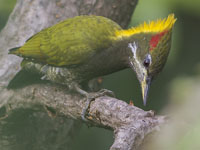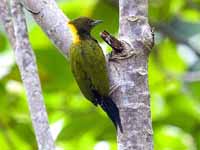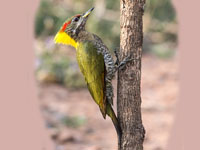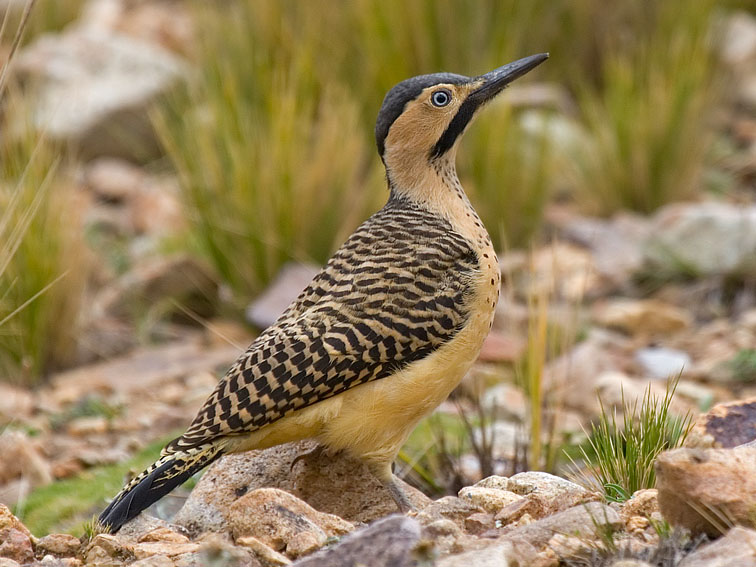The order Piciformes is made up of the woodpecker family Picidae plus 8 other families. Picidae make up about half of the species. In general, the Piciformes are insectivorous, but some exceptions eat mostly fruit. Nearly all Piciformes have parrot-like feet—two toes forward and two back, an arrangement that has obvious advantages for birds that spend much of their time on tree trunks. And most Piciformes do not have down feathers at any age, only true feathers. All nest in cavites.
Family Picidae: Woodpeckers and Allies
The woodpeckers family members are found almost worldwide. Most species live in forests or woodland habitats, although a few species are known to live in treeless areas such as rocky hillsides and deserts. They range in size from 8-50 cm. Many species exhibit patches of red and yellow on their heads and bellies, and these bright areas are important in signalling. Although the sexes of Picidae species tend to look alike, many have more prominent red or yellow head markings in males than in females.
Members of the family Picidae have strong bills for drilling and drumming on trees and long sticky tongues for extracting food. Species that use their bills in soil or for probing as opposed to regular hammering tend to have longer and more decurved bills. To prevent brain damage from the rapid and repeated decelerations, woodpeckers have evolved a number of adaptations to protect the brain. These include small brain size and the short duration of contact. The millisecond before contact with wood a thickened membrane closes, protecting the eye from flying debris. The nostrils are also protected, they are often slit-like and have special feathers to cover them. In addition to the strong claws and feet woodpeckers have short strong legs, this is typical of birds that regularly forage on trunks. The tails of most woodpeckers are stiffened, and when the bird perches on vertical surfaces, the tail and feet work together to support it. Picidae species can either be sedentary or migratory.
There are 7 articles pertaining to the woodpecker family Picidae: African, Eurasian, North America, South America, Small, Large, Terrestrial.
Most of the terrestrial woodpeckers obtain a considerable amount of their food while on the ground. They mainly eat ants, termites, beetles and their larvae; some also eat fruit and seeds. The New World terrestrial woodpeckers belong to genus Colpates. There are two sister genera in the Old World: Picus and Chrysophlegma. In fact, there used to be only a total of two terrestrial woodpecker genera, Chrysophlegma was seperated from Picus.
The Colpates New World woodpeckers typically have a brown or green back and wings with black barring, and beige to yellowish underparts with black spotting or barring. There are usually colorful markings on the head. They range in size from the grey-crowned woodpecker with a length of 17 cm to many Colpates species that are a little over 30 cm long. Many of these birds – particularly the northerly species – are more terrestrial than usual among woodpeckers. Some species, such as the crimson-mantled woodpecker, were formerly placed in the genus Piculus but moved to Colpates based on DNA analysis. Note that this classification was not made because they acted like a terrestrial woodpecker which is reflected by having "woodpecker" as part of their name instead of "flicker". Some Colpates species make their nest-holes only in earthen bankings, others make them only in trees, and some species use both approaches.
The Picus Old World woodpeckers typically have green upperparts. They are about the same size as their New World counter parts: 25 to 35 cm in length. Of the 13 species, two forage mostly in trees and 3 forage mostly on the ground; the remaining species forage at both places. Every member of Picus excavates its nest cavity in a tree. The three Chrysophlegma species used to be in Picus until DNA analysis indicated that they probably did not have a common ancestor. They all forage in trees, not on the ground. All of the species from these two genera are found in Asia; two of them are also found in Europe.
Each of the three genera that are described here have 1 species that is not listed as Least Concern. Perhaps the fact that most of the species are diverse and forage on trees as well as on the ground helps protected them.
Genus Colpates
Flicker,_Andean Colaptes rupicola
Description: The Andean flicker has dark brown upperparts with white bars and light grey underparts with a speckled breast, It has a buff head and neck, dark grey crown, and a black malar stripe. The Andean flicker has a long black bill, pale eyes, and yellowish legs. It is 32 cm long and weighs 150 to 200 grams. The nest is usually excavated in a banking; rarely in a tree.
Range: Andes of Pero, Bolivia, Chile, Argentana
Habitat: High altitudes rocky grassy areas where the bird is mostly terrestrial. Will use trees for lookouts.
Diet: Insects and their larvae. It probes the ground with its bill.
Conservation status: Least Concern.
Image by: 1, 2) Dick Daniels - Peru 3, 4) Nick_Athanas - ArgentinaRange: Andes of Pero, Bolivia, Chile, Argentana
Habitat: High altitudes rocky grassy areas where the bird is mostly terrestrial. Will use trees for lookouts.
Diet: Insects and their larvae. It probes the ground with its bill.
Conservation status: Least Concern.
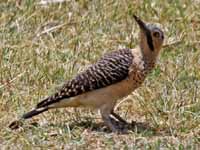
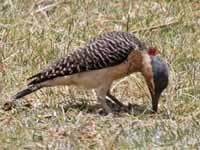
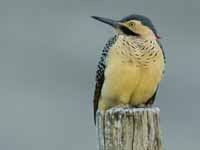
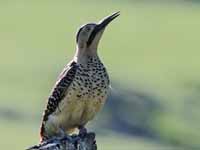
Flicker,_Campo Colaptes campestris Found: South America
Description: The Campo flicker has black upperparts barred white. It has yellowish golden ear-coverts, neck, and upper-breast. It has a black crown and nape, plus the throat is usually black. The southern subspecies c. c. campestroides has a white throat and is sometime deemed to be a separate species. The lower-breast and belly are whitish with thin black barring. Male has a reddish tinge to malar. The Campo flicker is about 30 cm long and 160 grams in weight. They create their nesting cavity in trees, termite mounds, or earth bankings.
Range: Central and eastern South America.
Habitat: Savanna. pampas, edges of forests.
Diet: Termites, beetles, ants. They forage on the ground.
Conservation status: Least Concern.
Image by: 1) Nick_Athanas - Brazil 2) Dario Sanches - Brazil 3) Cristiano Crolle - Argentina 4) Nathan_Hentze (I campestroideRange: Central and eastern South America.
Habitat: Savanna. pampas, edges of forests.
Diet: Termites, beetles, ants. They forage on the ground.
Conservation status: Least Concern.
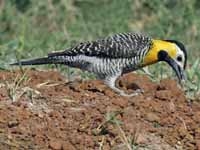
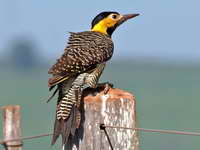
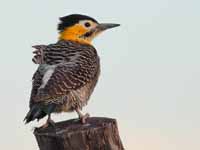
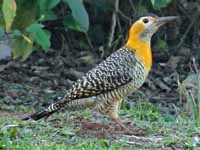
Flicker,_Chilean Colaptes pitius
Description: The Chilean flicker has mainly black and white barred plumage. There is little barring on the belly. It has a
bluish-grey crown plus a buffy face and throat. The male has a blackish malar region. They have a black bill and grey legs. The Chilean flicker is about 30 cm long and 100 to 160 grams. It creates a nesting cavity in trees or earth bankings. It is similar to the Fernandina's flicker, but their ranges do not overlap.
Range: Argentina, Chile.
Habitat: Dry or wet temperate areas with trees available.
Diet: Mainly ants; also larvae, grubs, scorpions. Feeds mainly on the ground.
Conservation status: Least Concern.
Image by: 1) Dominic_Sherony 2) Gabriel_Barrera_Maffioletti - Chile 3) Ben Tubby - Chile Range: Argentina, Chile.
Habitat: Dry or wet temperate areas with trees available.
Diet: Mainly ants; also larvae, grubs, scorpions. Feeds mainly on the ground.
Conservation status: Least Concern.
1, 2) Female 3) Male
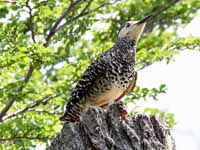
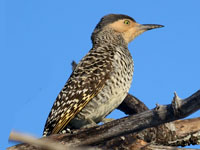
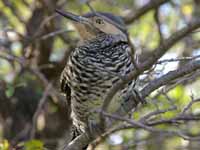
Flicker,_Fernandina's Colaptes fernandinae
Description: The Fernandina's flicker has black upperparts with white barring and tan underparts with faint black barring. The head is yellowish-tan with a slightly darker crown. The male has a black malar stripe. It is 30 to 34 cm long. This flicker nests mainly in palm trees. The nesting cavities are probably due to other woodpecker species. The Chilean flicker is similar to the Chilean flicker, but their ranges do not overlap.
Range: Cuba.
Habitat: Prefers to be near palm trees. Also denser woods.
Diet: Ants, termites, and other insects. Mainly forages on the ground, but also spends considerable time looking for insects in trees.
Conservation status: The Fernandina's flicker, with a population less than 1000, is listed as Vulnerable because of habitat loss.
Image by: 1) Gail_Hampshire 2) Laura Gooch 3) Blake Maybank 4)Range: Cuba.
Habitat: Prefers to be near palm trees. Also denser woods.
Diet: Ants, termites, and other insects. Mainly forages on the ground, but also spends considerable time looking for insects in trees.
Conservation status: The Fernandina's flicker, with a population less than 1000, is listed as Vulnerable because of habitat loss.
1) Female 2) Male
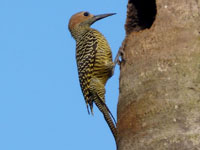
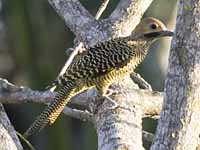
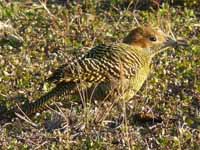
Flicker, Gilded Colaptes chrysoides
Description: The gilded flicker has greyish brown upperparts with thin dark brown bars. The underparts are whitish with black spots. There is a large black breast patch. The male has a red malar stripe. It is 28 cm long. It most frequently nests in the saguaro cactus. The gilded flicker has been considered to be a subspecies of the northern flicker. It closely resembles the western version of the northern flicker which is also called the red-shafted flicker. The gilder flicker has golden underwings versus red underwings for the red-shafted flicker version of the northern flicker while the gilded flicker has a brighter cinnamon crown.
Range: Southwest United States, northern Mexico.
Habitat: Giant cactus in the Sonoran Desert where it nests. Also found in woodland near running water.
Diet: Insects such as ants. Also fruit, seeds. It mainly forages on the ground, especially at ant hills.
Conservation status: Least Concern.
Image by: 1, 2) Andy_Blackledge 3, 4) Glenn Seplak - ArizonaRange: Southwest United States, northern Mexico.
Habitat: Giant cactus in the Sonoran Desert where it nests. Also found in woodland near running water.
Diet: Insects such as ants. Also fruit, seeds. It mainly forages on the ground, especially at ant hills.
Conservation status: Least Concern.
1, 2) Female 3, 4) Male
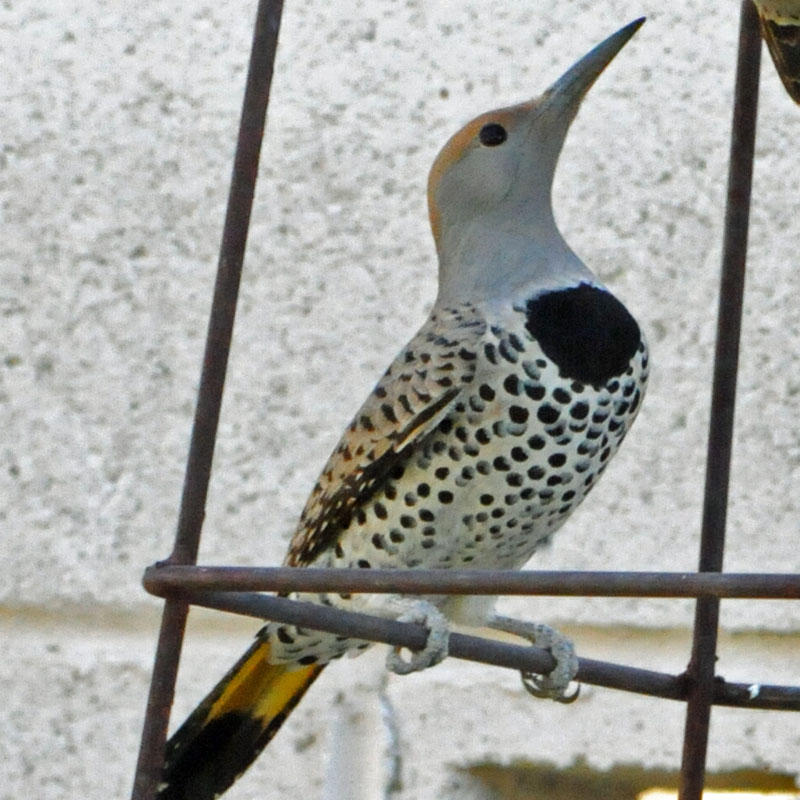

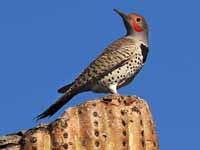
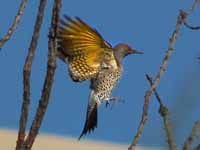
Flicker, Northern Colaptes auratus
Description: The northern flicker has a brown back with black bars. It has mainly beige underparts, a black patch on the upper breast, plus a beige lower breast and belly with black spots.
There are approximately 10 subspecies and they are grouped into two categories: the yellow-shafted flicker and the red-shafted flicker. The colors in their names refer to the yellow or red colors of the flight feathers, and especially the under surface of the wings. The males of these groups are significantly different as the yellow-shafted make has black malar stripes and the red-shafted males has a red malar stripe. Yellow-shafted males are found in eastern North America as well as Alaska and Canada. The red-shafted flickers are found in western North America. The northern flicker is 28 to 31 cm in length. They make their nest-holes in trees.
The red-shafted flicker is similar to the gilded flicker which has a brighter cinnamon crown.
Range: North America and Central America.
Habitat: Grasslands, open woodland, forest edge.
Diet: Mainly insects. Also fruit, seeds, nuts. They mainly forage on the ground, but can catch insects on the wing.
Conservation status: Least Concern.
Image by: 1) Dick Daniels - North Carolina 2) Mike & Chris - New Jersey 3, 4) Elaine R. Wilson and Alan D Wilson in Oregon and British Columbia The red-shafted flicker is similar to the gilded flicker which has a brighter cinnamon crown.
Range: North America and Central America.
Habitat: Grasslands, open woodland, forest edge.
Diet: Mainly insects. Also fruit, seeds, nuts. They mainly forage on the ground, but can catch insects on the wing.
Conservation status: Least Concern.
1) Yellow-shafted female q) Yellow-shafted male 3, 4) Red-shafted female and male
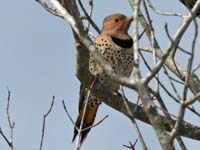
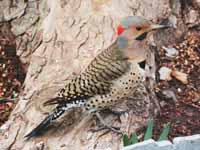
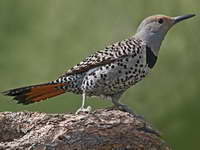
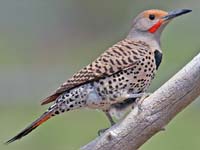
Woodpecker,_Black-necked Colaptes atricollis
Description: The black-necked woodpecker has green upperparts with black bars, a white breast with black barring, and a pale yellow belly with fainter barring. It has a black neck, upper breast, and black forehead. There is white on the cheeks that continues to the nape. The male has some red on the forehead, a red rear crown, and a red malar. The female only has red on the rear crown. They are about 26 cm long and weigh about 80 grams. Nests are excavated in trees, cactus, or riverbanks.
Range: Peru, probably extinct in Argentina.
Habitat: Dry wooded areas, montane scrub, desert scrub.
Diet: Ants in all phases of development. Forage mainly in trees, mainly by gleaning but sometimes pecking. Also forage on the ground.
Conservation status: Least Concern.
Image by: 1) Savithri_Singh - Peru 2) Charlie Westerinen - Argentina 3) Juan_Luna - Peru Range: Peru, probably extinct in Argentina.
Habitat: Dry wooded areas, montane scrub, desert scrub.
Diet: Ants in all phases of development. Forage mainly in trees, mainly by gleaning but sometimes pecking. Also forage on the ground.
Conservation status: Least Concern.
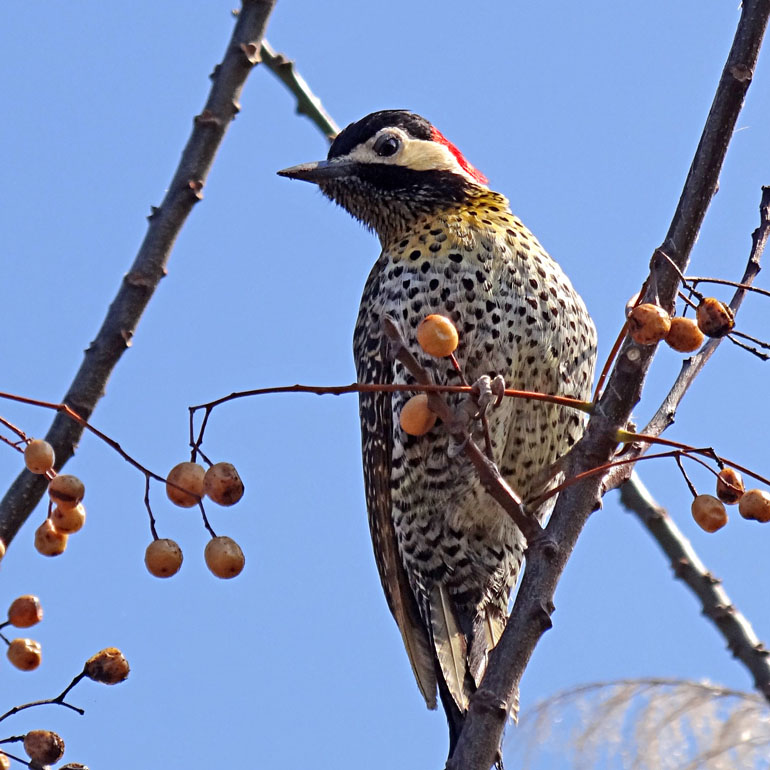
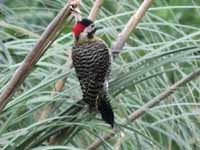
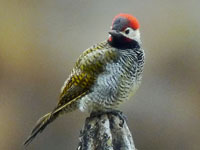
Woodpecker,_Crimson-mantled Colaptes rivolii
Description: The crimson-mantled woodpecker has a red mantle, back, and rear-crown. It has a black fore-crown (amount of black varies via subspecies), a black throat, and a black upper-breast. The lower-breast and belly are white. The male has a dark red crown and malar while on the female they are black. It is 26 cm long. The crimson-mantled woodpecker was formerly placed in the genus Piculus but moved to tthis genus based on DNA analysis. Note that the move was not made because it acts like a terrestrial woodpecker.
Range: Bolivia, Colombia, Ecuador, Peru and Venezuela.
Habitat: Forests and forest edges, usually between 1800 and 3500 meters.
Diet: Arthropods such as ants, spiders, millipedes, and beetle larvae. Also fruit. Usualy feed in trees, occasionally on the ground.
Conservation status: Least Concern.
Image by: 1) Nick_Athanas - Ecuador 2) Santiago Ron - Ecuador 3) Jerry Oldenettel - Ecuador 4) Alejandro_Tamayo - ColumbiaRange: Bolivia, Colombia, Ecuador, Peru and Venezuela.
Habitat: Forests and forest edges, usually between 1800 and 3500 meters.
Diet: Arthropods such as ants, spiders, millipedes, and beetle larvae. Also fruit. Usualy feed in trees, occasionally on the ground.
Conservation status: Least Concern.
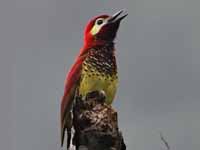
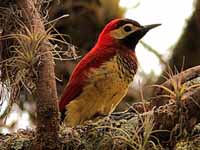
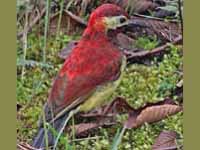
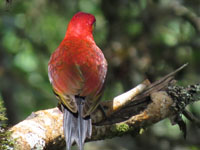
Woodpecker,_Golden-olive Colaptes rubiginosus
Description: The golden-olive woodpecker has plain golden-olive upperparts, barred underparts (some subspecies have yellow with no barring), and white cheeks continuing to nape. The fore-crown is grey and the rear-crown is red. The male has a red malar stripe.The golden-olive woodpecker is 20 cm long and weighs 75 grams. It excavates its nest cavity in a tree.
Range: Central and South America.
Habitat: Forests, more open woodlands and cultivated areas. It is most common in the mountains.
Diet: Mainly insects, including ants and beetle larvae; also some fruit and berries. Feeds in trees, not on the ground.
Conservation status: Least Concern.
Image by: 1) New Jersy Birds 2) Kale Ferguson 3) Alejandro_Tamayo 4 Gary_Clark 5) Dominic Sherony Range: Central and South America.
Habitat: Forests, more open woodlands and cultivated areas. It is most common in the mountains.
Diet: Mainly insects, including ants and beetle larvae; also some fruit and berries. Feeds in trees, not on the ground.
Conservation status: Least Concern.
1 - 3) Female 4, 5) Male
3) Subspecies Colaptes rubiginosus chrysogaster lacks barring on underparts
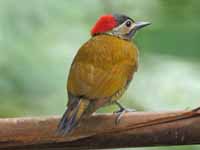
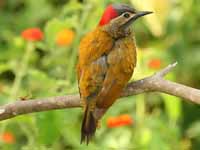
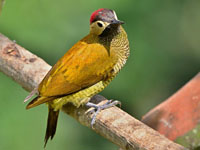
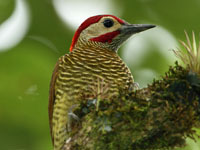
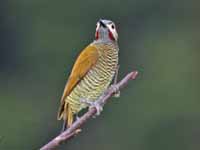
Woodpecker,_grey-crowned Colaptes auricularis
.Description: The grey-crowned woodpecker has a grey crown and nape. It has olive upperparts, cream colored face, and cream underparts with barring. The male has a red malar stripe. It is mediumd sized with a length of 17 cm and weight of about 60 grams.
Range: Pacific slope Mexico.
Habitat: Subtropical or tropical moist montane forests.
Diet: Insects, other invertebrates; also berries.
Conservation status: Least Concern.
Image by: 1) Laura_Gaudette 2, 3) Pete_Morris 4) Nick_AthanasRange: Pacific slope Mexico.
Habitat: Subtropical or tropical moist montane forests.
Diet: Insects, other invertebrates; also berries.
Conservation status: Least Concern.
1. 2) Female 3, 4) Male
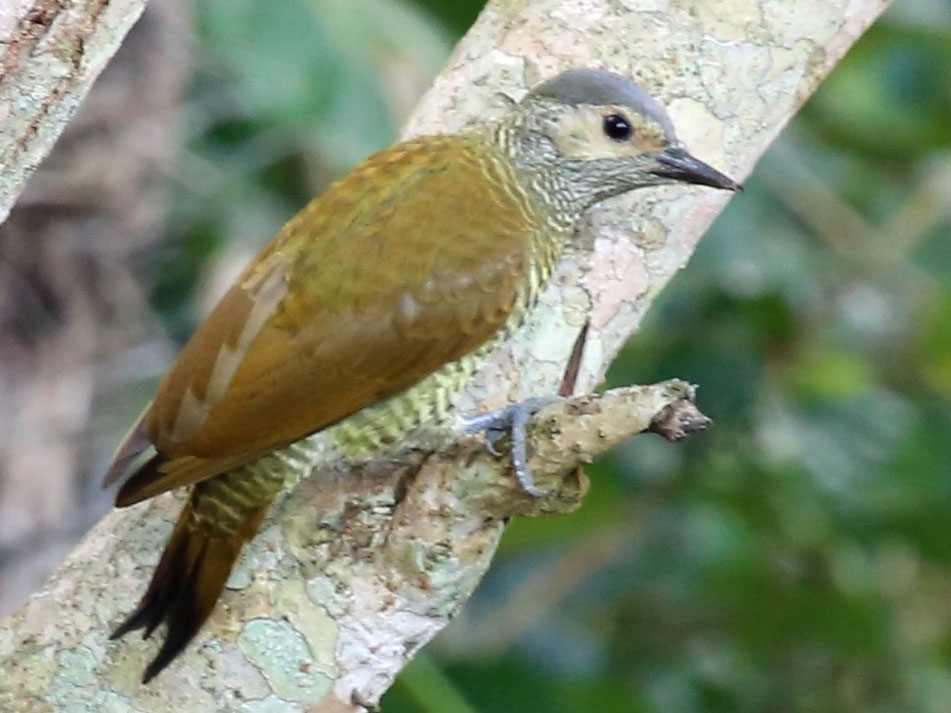
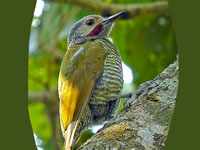
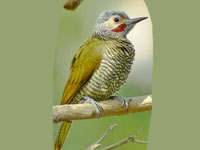
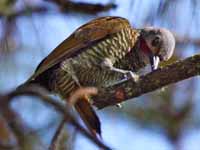
Woodpecker,_Green-barred Colaptes melanochloros
Description: The green-barred woodpecker has a dark brown back which is barred white with some yellowish-green tinge. It has a black fore-crown; red rear-crown, and red nape. The green-barred woodpecker is about 28 cm long. It has the nest in a tree or stump.
Range: Argentina, Bolivia, Brazil, Paraguay and Uruguay.
Habitat: Varied from lowland forests to desert scrub.
Diet: Mainly ants and termites; also other insects, fruit. It mainly forages on the ground, also in trees.
Conservation status: Least Concern.
Image by: 1) Cláudio Timm - Uruguay 2)
Dario Sanches - Brazil 4) Cristiano Crolle - Argentina 4) Gustavo_Duran - ArgentinaRange: Argentina, Bolivia, Brazil, Paraguay and Uruguay.
Habitat: Varied from lowland forests to desert scrub.
Diet: Mainly ants and termites; also other insects, fruit. It mainly forages on the ground, also in trees.
Conservation status: Least Concern.
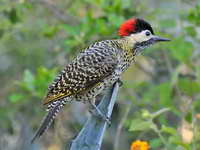
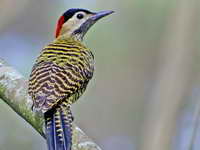
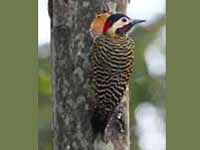
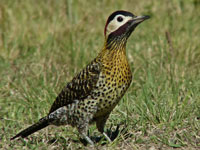
Woodpecker,_Spot-breasted Colaptes punctigula
Description: The spot-breasted woodpecker has olive upperparts with dark barring.,It has yellowish underparts with spots, and a black fore-crown. The rear-crown and nape are red, and it gas a red rear-crown. It has a white face and a black throat. The male has red between the white of its face and the black of its throat. It is about 19 cm long and weighs 60 grams. It excavtes a nest cavity in a tree. The similar golden-olive woodpecker lacks barring on its black.
Range: Panama, South America.
Habitat: Open areas with some trees.
Diet: Mainly ants; also other insects. Forages on trees and also on the ground.
Conservation status: Least Concern.
Image by: 1) birdphotos.com - Venezuela 2) Alejandro_Bayer_Tamayo - Columbia 3) Barloventomagico - Venezuela 4) Nick_Athanas - VenezuelaRange: Panama, South America.
Habitat: Open areas with some trees.
Diet: Mainly ants; also other insects. Forages on trees and also on the ground.
Conservation status: Least Concern.
1) Male, left, female, right 2) Female 3, 4) Male
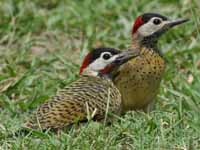
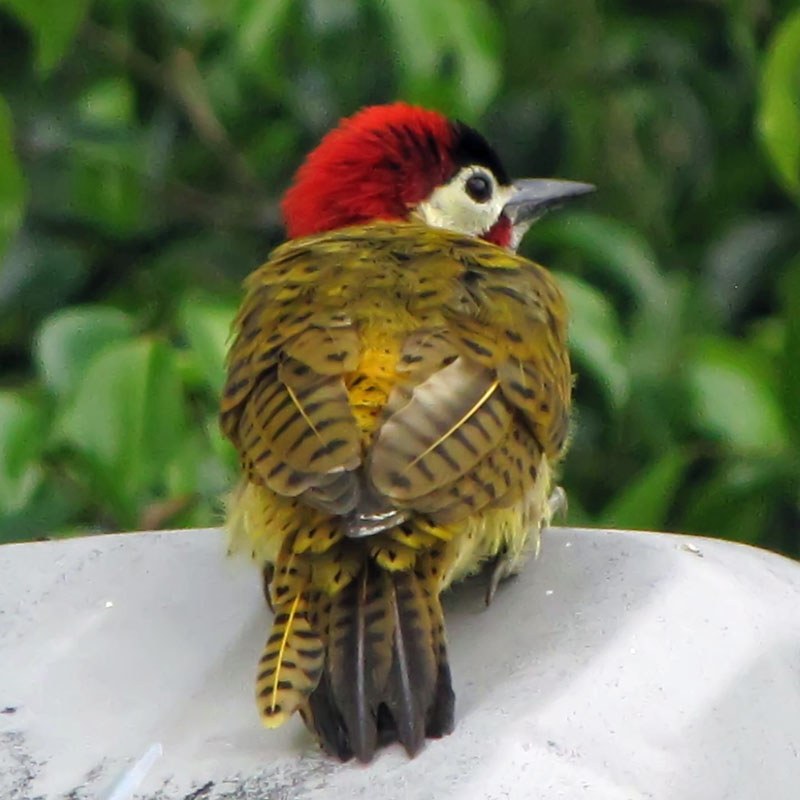
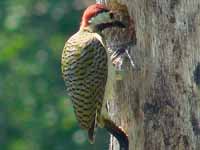
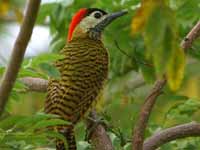
Genus Chrysophlegma
These Asian species used to be in Picus until DNA analysis indicated that there probably did not have a common ancestor. All three of the species that are described here, forage in trees, not on the ground.
Woodpecker,_Banded Chrysophlegma miniaceum
Description: The banded woodpecker has mainly rufous-brown upperparts, a yellow rump, and also a yellow nape. It has a reddish-brown chin, neck, and throat. The breast is reddish with olive bars and the belly is whitish with dark barring. The female has less red on her face. It is 23 to 26 cm long and weighs 80 to 105 grams. It excavates a nest hole in a tree.
Range: Brunei, Indonesia, Malaysia, Myanmar, Singapore, and Thailand.
Habitat: Mainly rainforest with vines, tangled shrubs and fallen trees. Also secondary forests and plantations.
Diet: Ants. Forages on trees and vines.
Conservation status: Least Concern.
Image by: 1, 2, 3) Lip Kee - Malaysia 4) Tan_JS - SingaporeRange: Brunei, Indonesia, Malaysia, Myanmar, Singapore, and Thailand.
Habitat: Mainly rainforest with vines, tangled shrubs and fallen trees. Also secondary forests and plantations.
Diet: Ants. Forages on trees and vines.
Conservation status: Least Concern.
1) Female, left, Male right
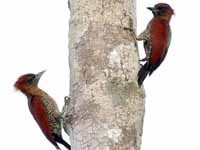
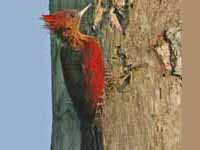
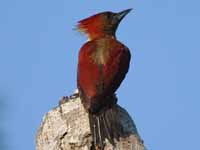
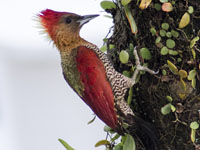
Woodpecker,_Checker-throated Chrysophlegma mentale
Description: The checker-throated woodpecker has bright green upperparts and duller green underparts. The head is also green with a yellow nape. The chin and throat are blackish with while checkers. The checker-throated woodpecker is about 27 cm long.
Range: Brunei, Indonesia, Malaysia, Myanmar, Singapore, and Thailand.
Habitat: Forests with large trees and dense undergrowth.
Diet: Ants, termites, beetles and their larvae. It forages in the trees, not on the ground.
Conservation status: The checker-throated woodpecker is listed as Near Threatened because of habitat degradation and loss.
Image by: 1, 2) Yip Lee - MalaysiaRange: Brunei, Indonesia, Malaysia, Myanmar, Singapore, and Thailand.
Habitat: Forests with large trees and dense undergrowth.
Diet: Ants, termites, beetles and their larvae. It forages in the trees, not on the ground.
Conservation status: The checker-throated woodpecker is listed as Near Threatened because of habitat degradation and loss.
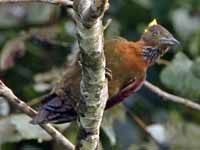
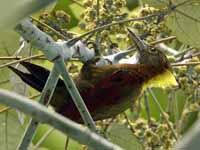
Yellownape,_Greater Chrysophlegma flavinucha Found: Asia
Description: The greater yellownape has green upperparts, grey underparts,a yellow nape, and an ivory bill. The male has a yellow malar stripe. It is 32 to 35 cm long and weighs 120 to 200 grams. It excavates a nest cavity in a tree. Both sexes incubate the eggs and feed the chicks.
Range: Asia - East Asia from northern and eastern India to south-eastern China, Indochina, Hainan, and Sumatra.
Habitat: Various types of forests, forest edges, and clearings,
Diet: Ants, termites, beetles and their larvae. Forages on trees, not on the ground.
Conservation status: Least Concern.
Image by: 1, 2) Dick Daniels - Miami Zoo 3) Batha 4) LonelyShrimpRange: Asia - East Asia from northern and eastern India to south-eastern China, Indochina, Hainan, and Sumatra.
Habitat: Various types of forests, forest edges, and clearings,
Diet: Ants, termites, beetles and their larvae. Forages on trees, not on the ground.
Conservation status: Least Concern.
1, 2) Female 3) Male
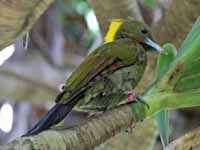
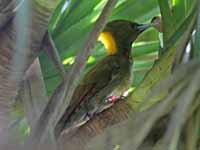
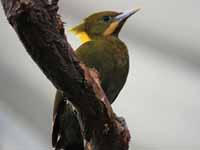
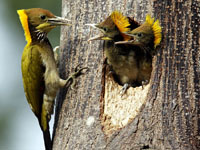
Genus Picus Found : mainly Asia
The Picus species typically have green upperparts. Genus Colaptes can be considered to be their New World counterparts. All are found in Asia and some also in Europe.
Woodpecker,_Black-headed Picus erythropygius Found: southeast Asia
Description: The black-headed woodpecker has a mainly black head. The male has a red patch in the center of the crown; the female does not. It has a yellow-green upper-back plus red lower-back and rump. The wing coverts are dark green. The chin, throat and upper-breast are bright yellow. The lower-breast and belly are brownish white with some faint chevrons on the breast and darker chevrons on the belly. The black-headed woodpecker is 33 cm long and weighs 100 to 135 grams. It has its nest in a tree cavity.
Range: Cambodia, Laos, Myanmar, Thailand, and Vietnam.
Habitat: Forests up to 1000 meters.
Diet: Ants, termites, and other invertebrates. Forages in trees and on the ground.
Conservation status: Least Concern.
Image by: 1) Dave_Curtis - Thailand 2) Brendan Ryan - Cambodia 3) Derek Ramsey Range: Cambodia, Laos, Myanmar, Thailand, and Vietnam.
Habitat: Forests up to 1000 meters.
Diet: Ants, termites, and other invertebrates. Forages in trees and on the ground.
Conservation status: Least Concern.
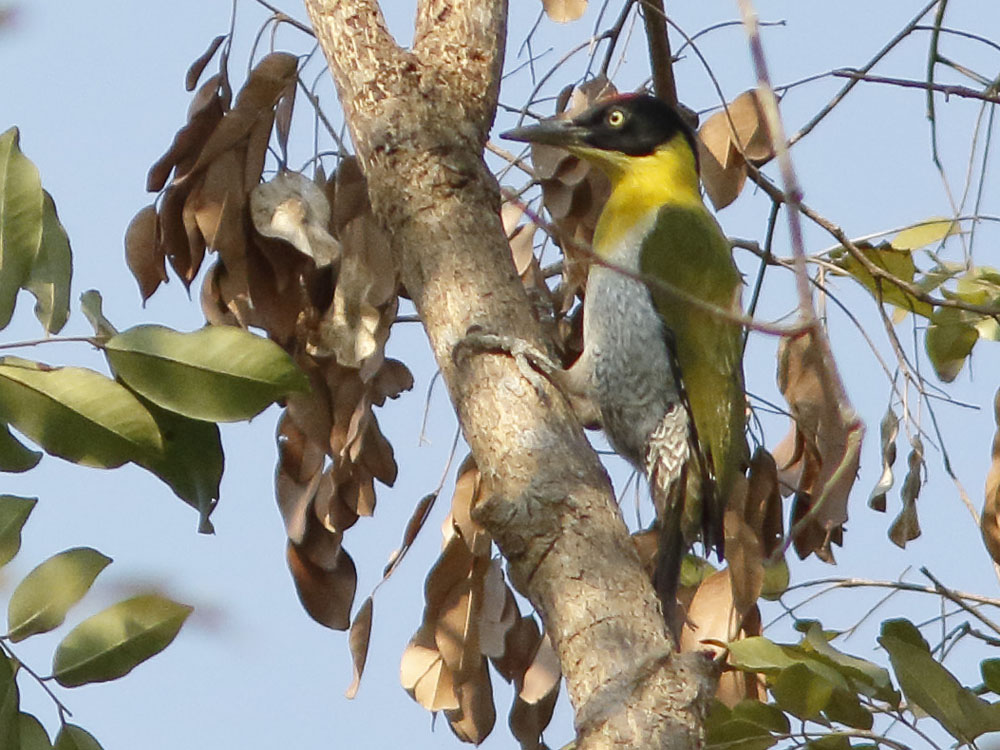
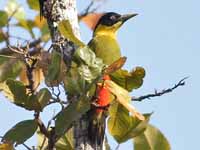
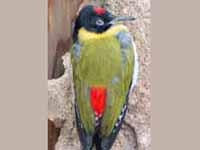
Woodpecker,_Crimson-winged Picus puniceus
Description: The crimson-winged woodpecker has green upperparts with a paler green rump. It has a red crown with a yellow crest on the nape. The male has a short red malar stripe; the female does not. The wing-coverts are red. The underparts are dark green. The crimson-winged woodpecker is 25 cm long and 65 to 95 grams. The nest is located in a tree cavity.
Range: Southeast Asia in Brunei, Indonesia, Malaysia, Myanmar, Singapore, and Thailand.
Habitat: Evergreen forests and woodlands, forest edges, plantations.
Diet: Ants, termites, larvae. Forages in trees by gleaning and hammering.
Conservation status: Least Concern.
Image by: 1) Naturelly 2) Francesco Veronesi - Thailand Range: Southeast Asia in Brunei, Indonesia, Malaysia, Myanmar, Singapore, and Thailand.
Habitat: Evergreen forests and woodlands, forest edges, plantations.
Diet: Ants, termites, larvae. Forages in trees by gleaning and hammering.
Conservation status: Least Concern.
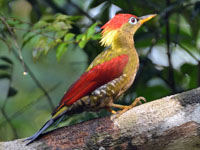
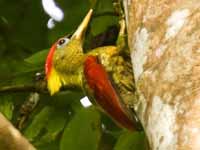
Woodpecker,_Eurasian Green Picus viridis
Description: The Eurasian green woodpecker , also known as the green woodpecker, has green upperparts, a yellow rump, pale yellowish underparts, red crown, red nape, and a black eye patch. The male has a red center to its malar stripe while the female has an all black malar stripe. It is 32 cm long and 160 to 250 grams. The nest is located in a tree cavity. The similar Grey-headed woodpecker and Levaillant's woodpecker do not have a black eye-patch. In Spain and Portugal the Eurasian green woodpecker is replaced by the Iberian green woodpecker.
Range: Europe, Asia.
Habitat: Areas where there is a combination of old deciduous trees for nesting, and nearby feeding grounds with plenty of ants.
Diet: Mainly ants. Also other insects and small reptiles. Forages mainly on the ground.
Conservation status: Least Concern.
Image by: 1) Frank Vassen - Belgium 2) Roger
Sanderson 3) Yannick 6) Cristiano Crolle - ItalyRange: Europe, Asia.
Habitat: Areas where there is a combination of old deciduous trees for nesting, and nearby feeding grounds with plenty of ants.
Diet: Mainly ants. Also other insects and small reptiles. Forages mainly on the ground.
Conservation status: Least Concern.
1, 2) Female 3, 4) Male
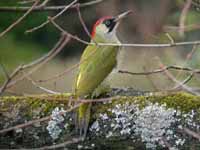
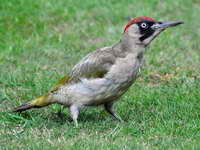
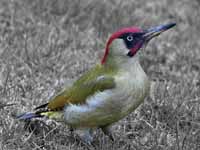
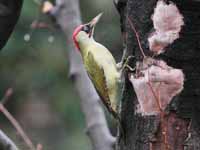
Woodpecker,_grey-headed Picus canus
Description: The grey-headed woodpecker, also known as the grey-faced woodpecker, has green upperparts with a yellow rump. It has pale grey underparts and head, a black moustache. Some subspecies have a black nape. The male has a red fore-crown. The grey-headed woodpecker is 28 toi 33 cm long. The nest is located in a tree cavity. The similar Eurasian green woodpecker has a black eye patch; the grey-headed woodpecker does not.
Range: The more northern parts of Europe and Asia.
Habitat: Old mixed coniferous forest with a high proportion of dead trees,
Diet: Mainly ants and termites. Also other insects, eggs, chicks, fruit. Forages on the ground; anf also in trees.
Conservation status: Least Concern.
Image by: 1) Andrey_Tsvirenko 2) Imran_Shah - Pakistan 3) Francesco_Veronesi - Italy 4) Koshy_KoshyRange: The more northern parts of Europe and Asia.
Habitat: Old mixed coniferous forest with a high proportion of dead trees,
Diet: Mainly ants and termites. Also other insects, eggs, chicks, fruit. Forages on the ground; anf also in trees.
Conservation status: Least Concern.
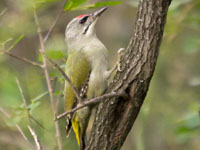
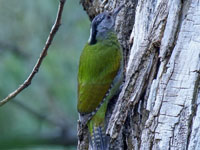
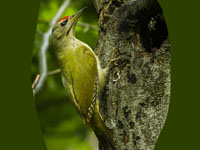
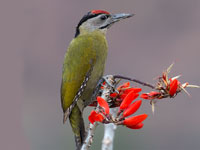
Woodpecker,_Iberean_Green Picus sharpei
Description: The Iberian green woodpecker has green upperparts, a green rump, pale greenish-white underparts, It has a greyish face. The male has a red malar stripe while for the female it is black. Both have a red crown and nape, but the female has grey mixed in. The Iberian green woodpecker is about 32 cm long and 190 grams. The nest is located in a tree cavity.
Range: Spain, Portugal.
Habitat: Mix of mature trees and grasslands.
Diet: Ants and other small invertebrates. Also fruit. Forages both in trees and on the ground.
Conservation status: Least Concern.
Image: 1, 2) Luis_García - SpainRange: Spain, Portugal.
Habitat: Mix of mature trees and grasslands.
Diet: Ants and other small invertebrates. Also fruit. Forages both in trees and on the ground.
Conservation status: Least Concern.
1) Female 2) Male
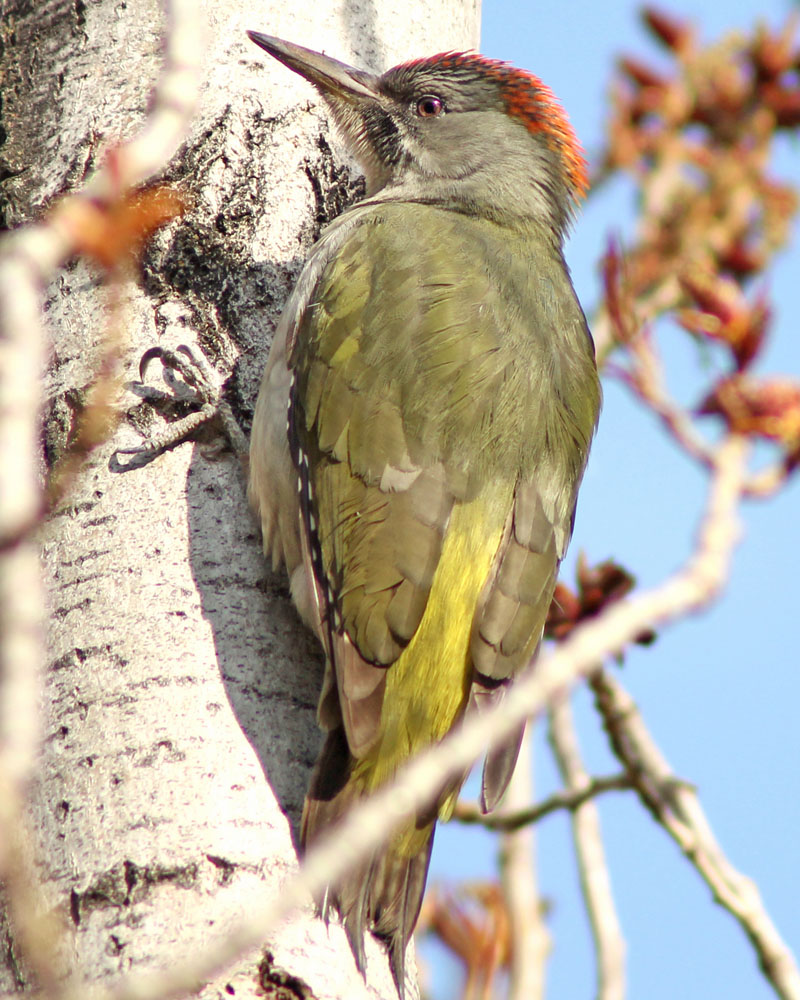
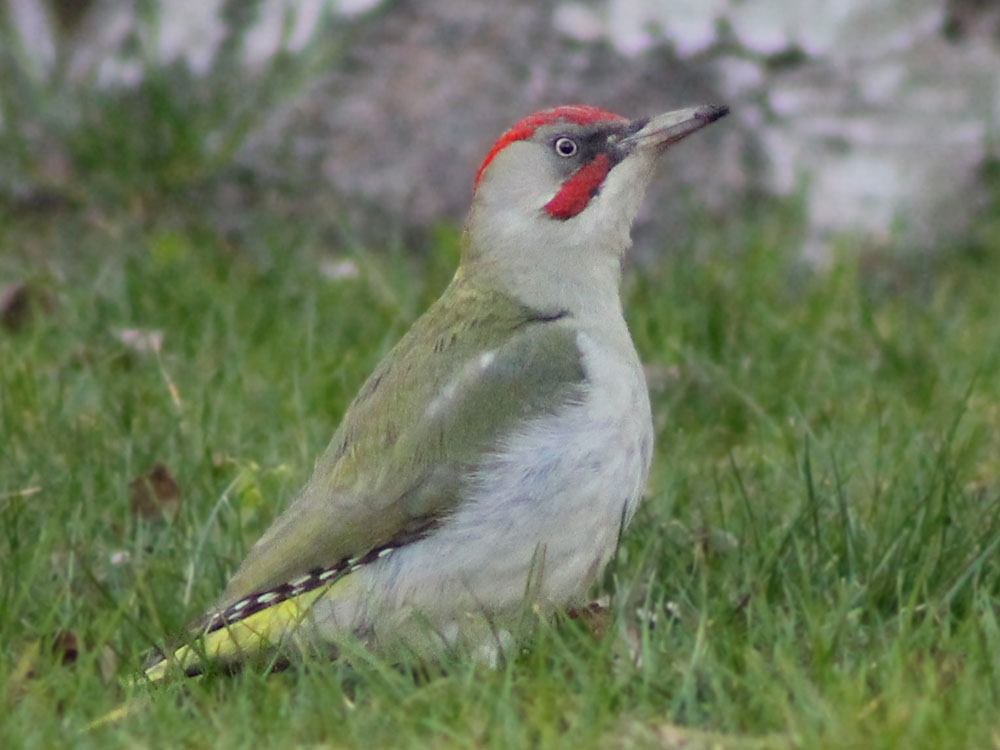
Woodpecker,_Japanese Green also Japanese Woodpecker Picus awokera
Description: The Japanese green woodpecker, also known as the Japanese woodpecker, has green upperparts. The face and chin are light grey. It has a black forehead, black lores, and a red nape. The male also has a red crown. The make has a black malar stripe with some red in the middle. the female has less red on her stripe. There are wavy black bars on the belly. The Japanese green woodpecker is about 30 cm long and 130 grans. It nests in trees. The Japanese green woodpecker is closely related to the Eurasian green woodpecker, but their ranges do not overlap.
Range: Japan.
Habitat: Open woodland; also parks and gardens.
Diet: Ants, other insects, larvae. Forages in trees by gleaning and pecking; spends little time on the ground.
Conservation status: Least Concern.
Image by: 1. 2) Tomossuke214 - Japan 3) Isalso known as Yoji - JapanRange: Japan.
Habitat: Open woodland; also parks and gardens.
Diet: Ants, other insects, larvae. Forages in trees by gleaning and pecking; spends little time on the ground.
Conservation status: Least Concern.
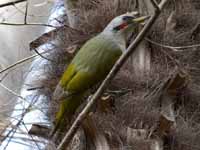
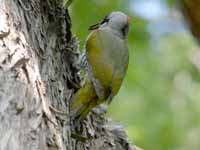
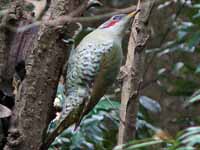
Woodpecker,_Laced Picus vittatus
Description: The laced woodpecker has yellow-green upperparts with the rump more yellow. The face is grey with a black malar stripe; there is a short white supercilium. The male has a red crown and nape while for the female they are black. It has a yellowish-buff upper-breast blending to greenish-white and a scaly appearance for the rest of the underparts. It is 30 to 33 cm long and weighs 95 to 130 grams. The nest is an excavated hole in a tree.
Range: Cambodia, Indonesia, Laos, Malaysia, Myanmar, Singapore, Thailand, Vietnam.
Habitat: Woodlands, plantations, gardens.
Diet: Beetles, and probably other insects, larvae, flies. Forages on trees and on the ground.
Conservation status: Least Concern.
Image by: 1) Lip Kee - Singapore 2) Andy Teo - Singapore 3, 4) Hiyashi Halso known as - MalaysiaRange: Cambodia, Indonesia, Laos, Malaysia, Myanmar, Singapore, Thailand, Vietnam.
Habitat: Woodlands, plantations, gardens.
Diet: Beetles, and probably other insects, larvae, flies. Forages on trees and on the ground.
Conservation status: Least Concern.
1) Pair, female on left 2) Female 3, 4) Male
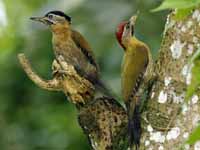
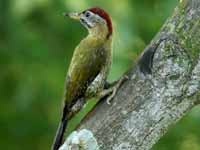
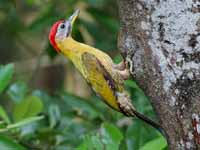
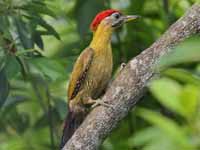
Woodpecker,_Levaillant's Picus vaillantii
Description: The Levaillant's woodpecker has green upperparts, lighter yellowish-green underparts, a crimson nape, crimson (male) or black (female) crown, black moustache, yellow rump, grey bill, and grey feet. The Levaillant's woodpecker is about 31 cm long. The nest hole is in a tree. It is similar to the Eurasian green woodpecker which has a black eye patch.
Range: Africa - Morocco, Algeria and Tunisia.
Habitat: Mountain forests up to the treeline at around 2000 m.
Diet: Ants and other insects. It forages mostly on the ground.
Conservation status: Least Concern.
Image by: 1) Ron_Knight 2) Francesco_Veronesi - Morocco Mark_GurneyRange: Africa - Morocco, Algeria and Tunisia.
Habitat: Mountain forests up to the treeline at around 2000 m.
Diet: Ants and other insects. It forages mostly on the ground.
Conservation status: Least Concern.
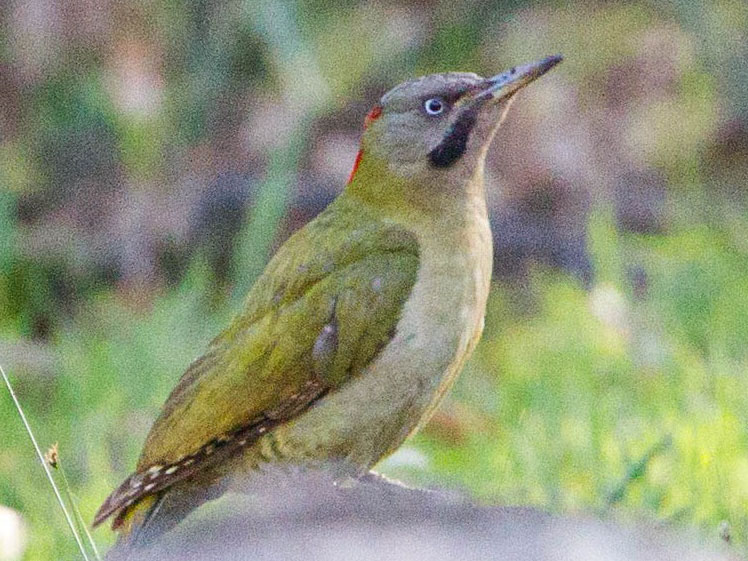
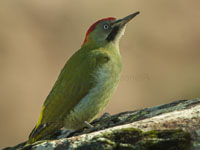
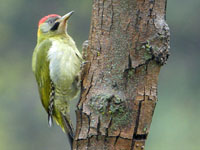
Woodpecker,_Red-collared Picus rabieri
Description: The red-collared woodpecker has green upperparts. The rump and most of the underparts are slightly paler than the upperparts. The upper-breast is red. The male has a red crown, nape, and collar. The female has a blackish crown and and less red on the rest of the head. They both have orange-grey lores and ear-coverts plus a greenish-buff chin. It is about 30 cm long.
Range: Cambodia, China, Laos, Vietnam.
Habitat: Wooded or bamboo groves with tall trees available.
Diet: Mainly ants. Feeds in trees and on the ground.
Conservation status: The red-collared woodpecker is listed as Near Threatened because of its limited range in which their habitat is degrading.
No image available.
Range: Cambodia, China, Laos, Vietnam.
Habitat: Wooded or bamboo groves with tall trees available.
Diet: Mainly ants. Feeds in trees and on the ground.
Conservation status: The red-collared woodpecker is listed as Near Threatened because of its limited range in which their habitat is degrading.
Woodpecker,_Scaly-bellied Picus squamatus
Description: The scaly-bellied woodpecker has greyish-green upperparts. It has a grey face which is bordered on both side by white. There is a black malar stripe.The male has a red forehead, crown, and nape. These are black on the female with grey streaks. They have an olive chin, throat, and upper-breast. The lower-breast and belly is whitish with a scaly appearance. The bill is yellow and the legs are greyish-green. It is 35 cm long and 150 to 200 grams.
Range: Afghanistan, Iran, India, Nepal, Pakistan, and Turkmenistan.
Habitat: Varied woodlands, usually from 1000 meters to tree-line.
Diet: Ants, termites, larvae of wood-boring insects. It probes on the tree for food and also forages on the ground.
Conservation status: Least Concern.
Image by: 1, 2, 3) Imran_Shah - Pakistan 4) Mvschreeram - ImdiaRange: Afghanistan, Iran, India, Nepal, Pakistan, and Turkmenistan.
Habitat: Varied woodlands, usually from 1000 meters to tree-line.
Diet: Ants, termites, larvae of wood-boring insects. It probes on the tree for food and also forages on the ground.
Conservation status: Least Concern.
1) Female 2 - 4) Male
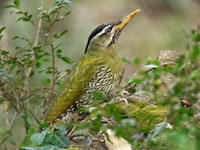
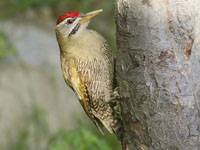
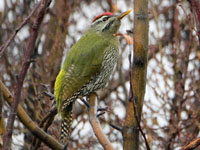
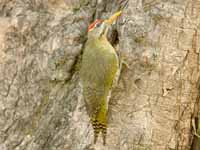
Woodpecker,_Streak-breasted Picus viridanus
Description: The streak-breasted woodpecker has green upperparts, a yellow-green rump, and green upper-tail coverts. The male has a red forehead, crown and nape. These areas are black for the female. They have a greyish-white face. The underparts are olive-green with a scaly pattern. It is 30 to 33 cm long and weighs 70 to 120 grams. The nest-hole is located in a tree.
Range: Southeastern Bangladesh to central Malay Peninsula.
Habitat: Subtropical and tropical lowland forests and mangroves.
Diet: Mainly ants. Usually forages on the ground, but also in trees.
Conservation status: Least Concern.
Image by: 1) Peter_Steward - ThailandRange: Southeastern Bangladesh to central Malay Peninsula.
Habitat: Subtropical and tropical lowland forests and mangroves.
Diet: Mainly ants. Usually forages on the ground, but also in trees.
Conservation status: Least Concern.
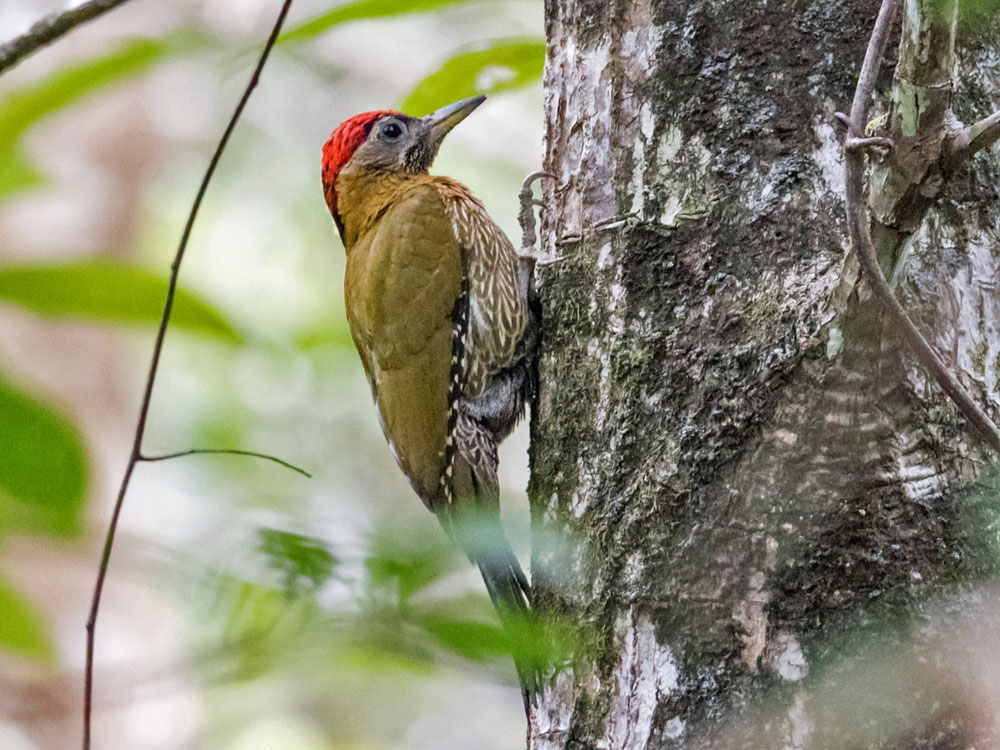
Woodpecker,_Streak-throated Picus xanthopygaeus
Description: The streak-cheeked woodpecker has olive-green upperparts, scaly off-white underparts, a yellowish rump, and a red (male) or blackish (female) crown plus nape. The chin and throat are whitish with dark streaks. It is 30 cm long and weighs 80 to 110 grams. The nest hole is excavated by the pair in a tree.
Range: Indian Subcontinent.
Habitat: Open woodlands, parks, plantations.
Diet: Ants, termite, other small insects and their larvae. Forages on the ground.
Conservation status: Least Concern.
Image by: 1) Venkatesh Sivaramakrishnan - India 2) Mr Bird Brain 3) Sivakumar Nilangiriyar 4) Allan Hopkins - IndiaRange: Indian Subcontinent.
Habitat: Open woodlands, parks, plantations.
Diet: Ants, termite, other small insects and their larvae. Forages on the ground.
Conservation status: Least Concern.
1, 2) Female 3, 4) Male
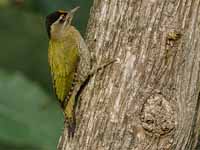
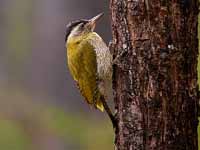
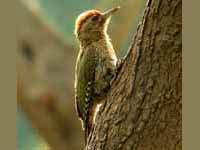
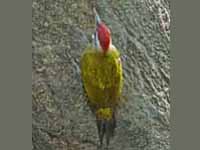
Yellownape,_Lesser Picus chlorolophus
Description: The lesser yellownape has green upperparts, a green head, yellow nape, white throat, whitish belly, and blackish tail. The male has a red moustachial stripe and some red on the crown. The female lacks the red malar stripe and the crown only has some red at the rear sides. It is 25 to 28 cm long and weighs 75 to 85 grams. Both sexes excavate a nest-hole in a tree. The greater yellownape is considerably larger.
Range: Indian subcontinent and Southeast Asia.
Habitat: Open woodlands, parks, plantations,
Diet: Ants, other small insects and their larvae. Forages in trees and on the ground.
Conservation status: Least Concern.
Image by: 1) Dibyendu_Ash - India 2) Franceso Veronesi - Malaysia 3) Koshy_KoshyRange: Indian subcontinent and Southeast Asia.
Habitat: Open woodlands, parks, plantations,
Diet: Ants, other small insects and their larvae. Forages in trees and on the ground.
Conservation status: Least Concern.
